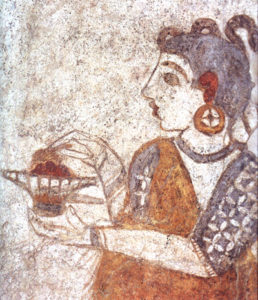
Fresco known as the “Young Priestess,” located between Rooms 4 and 5 of the West House at Akrotiri. Courtesy of the Thera Foundation.
When I first declared as a Classical Antiquities major, I was eager to learn more about the great minds of ancient Greece. Stories about men like Socrates, Pericles, and Alexander the Great fueled my ardent desire to learn more about Greek history. Upon enrolling in an Aegean Archaeology course, I was introduced to the Minoan civilization on the island of Crete. As I began to analyze Minoan art, I began to see a different narrative being told.
Their artistic representations convey a world where women out-dressed the men and were displayed in prominent positions of power and authority (in both size and scale) compared to their male counterparts. Instead of processions for kings, gifts and ceremonies are presented at the feet of a seated Goddess of Nature. The lack of fortifications and lack of representations of warfare create for a civilization quite the opposite from the brutal Mycenaeans. While there is no direct evidence for a matriarchy, it is clear the women played a very powerful and influential role in society.
Evidence of the Minoan’s pervasive influence was found on the neighboring island of Thera (Santorini) at a site called Akrotiri. After a devastating volcanic eruption there in 1650 BCE, most of the island’s inhabitants evacuated, leaving their homes and belongings to become preserved in volcanic deposits for thousands of years. Excavations in the 1960s unearthed ornate frescoes, many of which display women and girls doing a wide array of social and ritualistic activities.
The fresco I found most intriguing was one entitled “Young Priestess.” The figure is portrayed as young, based off of the blue of her shaven head and the snake-like tendrils of her hair. She wears a yellow shaggy robe passing over one shoulder, which in Egyptian art is considered a sign of priestliness.¬†She is seen passing from Room 4 into Room 5 sprinkling what is thought to be saffron on to an incense burner.¬†Her liminal position between rooms is notable, as this could symbolize the transition from youth to womanhood or from adorant to priestess.
 Depictions of women in positions of authority, especially in comparison to their male counterparts, was revolutionary to me. The “Young Priestess” represents the powerful role that even young girls had in the Minoan world. In studying a historically patriarchal region of the world, it was incredibly powerful to know that a great civilization could survive and thrive under peaceful and (potentially) feminine leadership.
Depictions of women in positions of authority, especially in comparison to their male counterparts, was revolutionary to me. The “Young Priestess” represents the powerful role that even young girls had in the Minoan world. In studying a historically patriarchal region of the world, it was incredibly powerful to know that a great civilization could survive and thrive under peaceful and (potentially) feminine leadership.
-Brittany Wade
Junior Girl
Girl Museum Inc.
